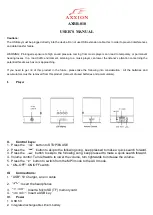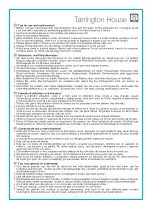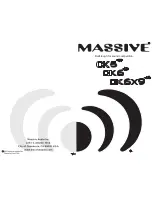
Design Philosophy
A studio monitor is really a tool used to aurally “measure” the changes in an audio
path. Ask any pro or semi-pro recordist what they think makes a great studio moni-
tor and you’ll get basically the same answers: “Accuracy, transparency, flat
response, and the truth”.
Everybody is saying the same thing – they want the electrical signal going in to a
monitor to be reproduced mechanically by the transducers and they want that to
happen without any degradation to the original signal. Professionals need to trust a
speaker to deliver their artistic vision in a way that will translate to a variety of audio
mediums. How you get there from a technical stand point is by designing a speaker
that eliminates or minimizes several damaging conditions. The KRK design philoso-
phy is manifested by paying very close attention to what we call the three corner-
stones:
1. Spectral Balance (Timbre)
What people tend to think sounds good is not necessarily “flat response”. A perfect-
ly flat monitor tends to sound harsh and abrasive – technically correct but not very
musical. Research shows us that a speaker with the proper
spectral balance
is
most often considered
“a great studio monitor”
.
Spectral balance is defined by:
• Smooth on-axis (not necessarily flat) response
• Smooth octave to octave response
• Smooth off-axis response (not necessarily flat)
From years of listening to feedback from some of the top engineers and producers
we’ve come to understand how a properly tuned monitor can become a valuable
recording tool.
2. Distortion Management
Any loss or addition to the audio signal is a distortion. Various amplifier distortions
have been eliminated; the most common being intermodulation, transient intermod-
ulation and harmonic distortion.
Distortion can be present in an amplifier circuit but can really be a problem when
the waveform is impacted by physical conditions such as port turbulence and dif-
fraction. KRK engineers implement design concepts that eliminate or minimize
these damaging conditions.
3. Resonance Management
Resonance is the tendency of something to vibrate at a particular frequency after
the source of energy is removed.
Resonances also play a major role in impacting the performance of a speaker. KRK
design elements minimize driver and enclosure resonance.
Design Elements
Active Filter Crossovers
- The V-Series 2 power amplifier contains three active fil-
ters. (Subsonic, low-pass and high-pass filter) These three filters work together to
provide a seamless integration of the driver components ensuring a smooth spec-
tral balance.
Bi-amplifier Design
– KRK’s amplifier consists of audiophile grade components
and a simple audio path for transparency. Output power is balanced to match LF
and HF driver sensitivities and power handling. Your V Series 2 monitor uses a
toroidal power transformer for low hum and minimum noise.
Resonant Free Enclosure Design
- The cabinetry of your V Series 2 monitor is
constructed from inert medium density fiberboard. It is internally braced and care-
fully damped to minimize cabinet resonance.
Radiused Edges
- All cabinet edges and port openings are heavily radiused to
reduce diffraction resulting in better detail and stereo imaging.
Slotted Ports
– Slotted ports reduce the port turbulence and distortion commonly
found in poorly designed round ports.
Custom Made Drivers
- KRK is renowned for designing high performance studio
monitor drivers. Your V Series 2 is no exception. A woven Kevlar® LF driver was
custom-designed specifically for each model. Kevlar® is one of the strongest, light-
est, most rigid materials that can be used in modern speaker cone construction
Kevlar’s unique physical properties minimize axial or conical break up modes. A
1inch soft dome tweeter was designed for detailed and accurate high frequency
reproduction. Ferrofluid is used for increased thermal power handling and
increased damping.
Defeatable Limiter
- Your V Series 2 monitor contains a transparentl limiter circuit
designed to mitigate the negative effects of over driving the amplifier or the speak-
er. The limiter, when engaged, can greatly reduce the risk of harming a driver. It
can however be defeated using the “Clip Off/Limiter Switch” on the rear panel. This
is only recommended if you are using the product well within a listenable volume
range. Use the indicators on the front baffle to help determine the optimum level
without audible distortion
2
3


























